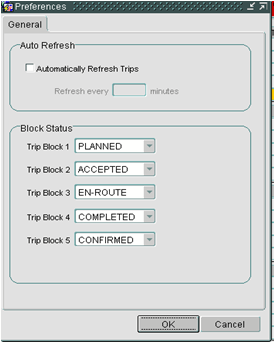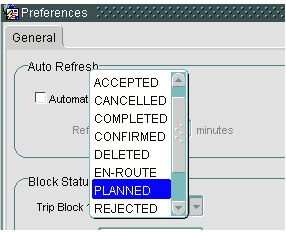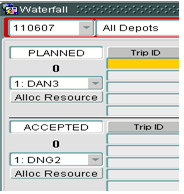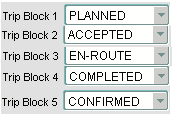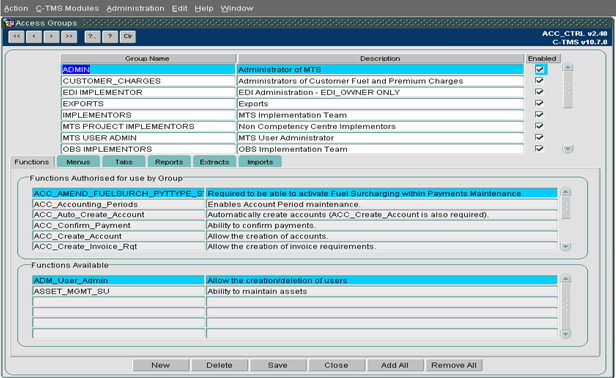288550
![]()
DHL C-TMS
Order Nos in Waterfall Screen
FUNCTIONAL SPECIFICATION - 10.6
10/06/2011 - 1.1
Reference: FS 288550 DK-8GWF4E
Functional Overview
Client Requirement
Change Request Summary:
Order Numbers need to be visible in the Waterfall screen.
Change Request Details:
For the customer to have access to the Waterfall screen and be able to see the status of the orders on the associated trips the order numbers will need to be added to the waterfall screen. As the order number is the only relevant number to the customer this is the only way they will be able to identify the status of the trip / order. We have looked at the TRIP EXECUTION screen as suggested by Dave Meir but this screen does not automatically refresh and would not be the best screen to give access to the customer.
Benefits identified as a result of the change:
This was part of the "SELL" to the customer that we would be able to let them see the status of the trips / orders.
Solution
Viewing order details will be controlled using a Cost Centre parameter.
If the cost centre parameter is set, the order data items Oms ref and external ref will be added to the configurable block on the Waterfall screen. The two fields will be available to select for each status block.
Currently the screen is based on a view (V_TRIP_OVERVIEW) which selects trip and stop details. A new view will be created based on the existing view , but also including order information for Loaded orders(V_TRIP_OVERVIEW_ORDERS). 5 new data blocks will be created based on this view.
Five new tabs will be created and named as follows :
PLANNED_ORD
ACCEPTED_ORD
EN-ROUTE_ORD
COMPLETED_ORD
CONFIRMED_ORD
The new tabs will be based on V_TRIP_OVERVIEW_ORDERS and will include the loaded order data. Users will use the preferences pop up screen to select the new tabs . The new tabs will only be available if the cost centre parameter has been set.
If a user has selected the new trip blocks, they should be including at least one order data field in the configurable items, otherwise the data will appear as duplicate trip information.
Scope
This change will be applied to system version 10.6.0.
Set-up
Pre-requisites
None
Menu Structure
‘Unchanged’
Data
One new system parameter
| NAME | VALUE | DESCRIPTION | CONFIG_BY | CONFIG_
VALUE |
| TRM_ORD_OVERVIEW | Y | Y or N, indicates whether the ORD_ <STATUS> are available in the preferences form in Waterfall | COST CENTRE | DHLOPE |
New records added to new table PREFERNCE_STATUS
| STATUS |
| ORD_DELETED |
| ORD_CANCELLED |
| ORD_PLANNED |
| ORD_ABANDONED |
| ORD_COMPLETED |
| ORD_ACCEPTED |
| ORD_EN-ROUTE |
| ORD_CONFIRMED |
| ORD_TENDERED |
| ORD_REJECTED |
| ORD_SEMI_FIXED |
New record added to ADM_FUNCTION
| FN_NAME | DESCRIPTION |
| SET_PREFERENCES | Allows users to apply a preference in Waterfall to a user group |
Functional Description
The Waterfall screen is based on a database view, V_TRIP_OVERVIEW, which looks at the trip stop details. A new view will be created to include order details of orders loaded on the trip. The link to non conformance will be based on an outer join as not all orders will have non conformance records.
| SCH_TRIP_STOP
|
SCH_HAULAGE_ACTIVITY | SCH_ORD | ||
| Stop_id
|
Stop_id
Oms_ref Activity_name = ‘Load’ |
Oms_ref
External_ref |
| SCH_ORD_NON_CONFORM | ||||
| Oms_ref
Reason_comments
|
The new view will result in the trip information being duplicated for each order loaded on the trip. Users who do not want to see order information in the waterfall screen should still be able to view the current display based on the original view.
To allow this, the existing control blocks will be copied.
Currently, there are 20 control blocks which determine which status are reported in the Waterfall screen. The user selects the Preference tab from the right click menu and the selection made by the user is used to set the control blocks.
| TRIP_BLOCK1_CTRL | TRIP_BLOCK2_CTRL | TRIP_BLOCK3_CTRL | TRIP_BLOCK4_CTRL | TRIP_BLOCK5_CTRL |
| TRIP_BLOCK1 | TRIP_BLOCK2 | TRIP_BLOCK3 | TRIP_BLOCK4 | TRIP_BLOCK5 |
| TAB_BLOCK1 | TAB_BLOCK2 | TAB_BLOCK3 | TAB_BLOCK4 | TAB_BLOCK5 |
| TAB_BLOCK1_CTRL | TAB_BLOCK2_CTRL | TAB_BLOCK3_CTRL | TAB_BLOCK4_CTRL | TAB_BLOCK5_CTRL |
Another 20 data blocks will be created and named as below. The new data blocks will be based on the new view and will be placed over the original blocks. Block 6 will be stored above block1, block7 above block 2 etc.
| TRIP_BLOCK6_CTRL | TRIP_BLOCK7_CTRL | TRIP_BLOCK8_CTRL | TRIP_BLOCK9_CTRL | TRIP_BLOCK10_CTRL |
| TRIP_BLOCK6 | TRIP_BLOCK7 | TRIP_BLOCK8 | TRIP_BLOCK9 | TRIP_BLOCK10 |
| TAB_BLOCK6 | TAB_BLOCK7 | TAB_BLOCK8 | TAB_BLOCK9 | TAB_BLOCK10 |
| TAB_BLOCK6_CTRL | TAB_BLOCK7_CTRL | TAB_BLOCK8_CTRL | TAB_BLOCK9_CTRL | TAB_BLOCK10_CTRL |
The difference between the new view and the existing view will be four fields and the data frequency. The four new fields added to the V_TRIP_OVERVIEW_ORD view will be oms_ref, external_ref, reason_code and reason_comment.
The TRIP_BLOCK and TAB_BLOCK data blocks are based on the views. Blocks 1 to 5 will remain based on the original view and blocks 6 to 10 will be based on the new view.
Blocks 1 and 6 , 2 and 7, 3 and 8 etc will be stored on the same tab and the display of each block will be controlled by the user preferences. To achieve this, the items in each block must be identical. The user will select a select a STATUS, an original Status will result in the original block being displayed and the new block hidden.
The original blocks will require the oms_ref ,external_reference, reason_code and reason_comment items to be added so they have the same items as the new blocks. As these fields do not exist in the original view, the items will be added as non data base items and will never be populated.
When the user selects OK, if the value selected for any of the blocks starts with ORD, the new block will be displayed instead of the original block. This will be achieved by hiding the original block. Once the block display has been resolved the value of the status will be manipulated and used to set the status field on the relevant control block.
To manipulate the data, the substr and ltrim functions will be used to extract the status from the preference. (Developers Note – see notes in folder)
Storing and Re Using Preferences
Currently, when the user selects preferences, they only last for the duration that the screen is open. The next time they enter the screen, a default setting is used based on values in the SCH_TRIP_STATUS table.
A new table, TRIP_OVERVIEW_PREF will be created which will store a preference against a user, allowing the preference to be used every time the screen is opened. The new table will store the user name and the status against each block.
Currently when the form is opened, the.F_INITIALISE_TRIP_BLOCKS selects the default preference from the SCH_TRIP_STATUS table. A new cursor in this procedure will first search for a record in the new table (TRIP_OVERVIEW_PREF) for the current user. If a record is found, this will be used to set the block where clause and determine which block is displayed. (Developer Notes – see attached )
Whichever status is used to set Block1, the same status will be used to set Block6, the blocks will always be linked as follows:
| BLOCK1 | BLOCK6 |
| BLOCK2 | BLOCK7 |
| BLOCK3 | BLOCK8 |
| BLOCK4 | BLOCK9 |
| BLOCK5 | BLOCK10 |
A new procedure will be created, called F_SHOW_SELECTED_BLOCKS. This will be called as part of the initialisation and will determine which block is displayed on the tabs. The records in the new TRIP_OVERVIEW_PREF table will be used to determine for each sequence 1 to 5, whether the original blocks or new order blocks are displayed. If there is no record in the preference table, the original blocks will be displayed.
The preference screen will be based on the new TRIP_OVERVIEW_PREF table and will list the five status fields.
When the user selects OK, this will be saved in the new table as follows
| USERNAME | SEQUENCE | PREF_STATUS |
| MTS_OWNER | 1 | PLANNED |
| MTS_OWNER | 2 | ACCEPTED |
| MTS_OWNER | 3 | EN-ROUTE |
| MTS_OWNER | 4 | COMPLETED |
| MTS_OWNER | 5 | CONFIRMED |
A new command button will be displayed on screen called APPLY_TO_GROUP. This buttons display will be controlled by new function called SET_PREFERENCES. This function will be assigned to certain user groups, using the ACCESS_CONTROL screen, meaning only specific people will see the command button.
When a user has defined a preference, selecting the new button will display a small pop up screen. The pop up screen will contain a field called group name. A list of values will be provided, listing all the groups available. When the user selects a group and selects OK, all the users in the group will be identified. If records already exist for the user in the preference table then no further action will be taken. If there are no records for the user, the current preference will be added to the table for the user. (Developer see notes).
A checkbox will also be available on the screen, called OVERWRITE. If this is checked, any records in the preference table for any of the users in the group will be removed and the current preference will be created for all users in the group.
Configurable Layout
Within each block on the main screen, the user is able to right click and select configure layout. The configure layout will always be based on the current block selected. Code must be added to allow users to configure layout for the new order blocks.
To achieve this, the following procedures will be copied for blocks 6 to 10
F_ATTRIBUTES_INITn
F_ADD_BLOCKn_ITEMS
If the user has chosen a non ORD status, the OMS_REF ,EXTERNAL_REF, ITEM_CODE and ITEM_COMMENTS will not be available in the configurable layout. If the user has chosen an ORD status, the four order based fields will be available in the configurable layout.
If the user selects ITEM_CODE or ITEM_COMMENTS, the data will be displayed in RED FONT.
If a user has chosen an ORD status, they should configure their layout to include the order fields.
Table Updates Required
Create table TRIP_OVERVIEW_PREF
| USER_ID | VARCHAR2(25) |
| SEQUENCE | NUMBER |
| PREF_STATUS | VARCHAR2(25) |
| CREATED_DATE | DATE |
| CREATED_BY | VARCHAR2(25) |
Create table PREFERENCE_STATUS
| PREF_STATUS | VARCHAR2(25) |
References
| EST-288550 DK-8GWF4E Order Nos in Waterfall Screen v1.0 | |||
Glossary
| C-TMS | Calidus TMS |
Document History
| Initial version | ||||
| Reviewed | ||||
| Added reason code and description. Review and Issue | ||||
AUTHORISED BY
| Matt Crisford | Development Manager | |
| Peter Greer | TMSCC MTS Product Manager |
